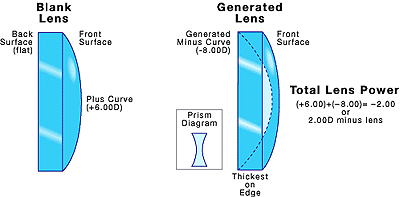To make a lens, the first thing you need is a lens blank. Blanks are made in factories and shipped to individual labs to be made into eyeglasses. The raw lens material is poured into molds that form discs about 4 inches in diameter and between 1 and 1 1/2 inches thick. The bottom of the mold forms a spherical curve on the front face. A small segment with a stronger curve may be placed in the mold to form the segment for bifocals or progressive lenses.
How the Lens is Made
In the lab the patient's full prescription gives these exact details:
- The total power (in diopters) the finished lens must have.
- The strength and size of the segment (if needed).
- The power and orientation of any cylinder curves.
Details such as the location of the optical center and any induced prism that may be needed.
The lab technician selects a lens blank that has the correct segment (called an add) and a base curve that is close to the prescribed power. Then to make the power match the prescription exactly, another curve is ground on the back of the lens blank.
In most labs the equipment is designed to grind minus curves, so a strong, plus lens blank is usually selected.
If the base curve is too strong, then a minus curve is ground in the back of the lens, which reduces the total power of the lens.
For example, a very common lens blank is +6.00 diopters. If the prescription calls for a total of +2.00 diopters, a -4.00 diopter curve is ground on the back: (+6.00D) + (-4.00D) = +2.00D. (See the illustration below.) If it is needed, the cylinder curve is also ground at the same time.
If the prescription calls for a minus lens, the +6.00 diopter lens blank can still be used. To create a lens with the strength of -2.00 diopters, a -8.00 diopter curve is ground on the back: (+6.00D) + (-8.00D) = -2.00D.


No comments:
Post a Comment